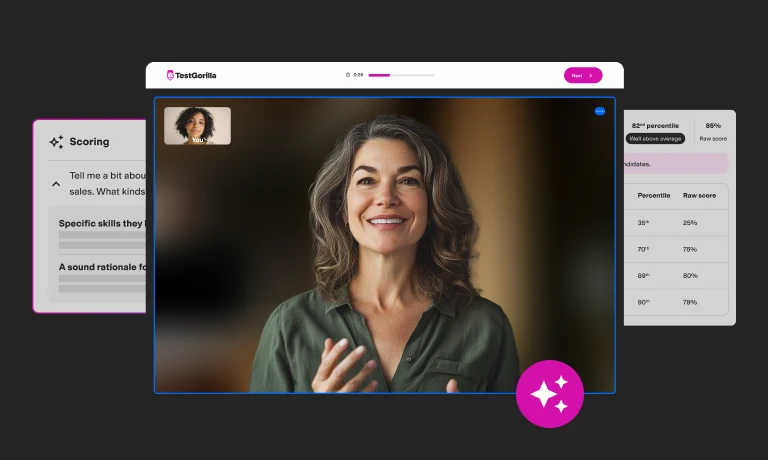You’ve reviewed resumes, conducted interviews, and run your pre-employment testing to find the perfect person for the job. The next task? Crafting a legally compliant employment contract.
Employment contracts are an excellent way to protect the rights of both the employer and employee, ensuring a smooth employment relationship. However, you must prepare these documents properly to be fair to the employee, or you risk having an unenforceable contract, which could lead to costly legal conflicts.
This article looks at the key clauses you may want to include in your contract. There’s also a step-by-step guide on how to draft an employment agreement and access to useful templates.
What is a contract of employment?
An employment contract is an agreement between an employer and an employee describing the details of the employment relationship. It lays out the rights and responsibilities of the employer and the employee by addressing issues such as the length and nature of the employment, work hours, compensation, and termination.
“Job contract,” “employment agreement,” or “work contract” are other terms commonly used for employment contracts.
Businesses of all sizes and across all industries use employment contracts. These agreements can be written or verbal. They can also be implied without formal agreement, but the parties’ conduct and communications indicate an employment relationship.
If you choose to use a written employment contract, it must be signed by both parties before the employee starts work.
Why have a written employment contract?
You may not be required by law to have a written contract with your employees. However, there are several reasons why businesses choose to do so.
Employment contracts are legally binding documents that protect the rights of both employers and employees. For employees, an employment agreement usually outlines the pay and any benefits they can receive, ensuring they are compensated for their work.
Employment agreements also protect the employer’s legal interests. For example, non-disclosure clauses prevent employees from sharing the company’s trade secrets, thus protecting its intellectual property.
Putting the details of an employment relationship in writing ensures the parties are clear on their respective rights and responsibilities and the consequences for breaching them. This reduces the risk of a dispute or other issues arising, including litigation, which is often time-consuming, costly, and stressful for everyone involved.
From an employer’s perspective, a contract defines the key terms of the relationship, such as paid time off and overtime. With these in writing, the employer can budget pay and manage work schedules accordingly.
Different types of employment contracts
At-will
At-will contracts don’t specify a duration. They allow both parties to terminate the employment relationship at any time, with or without reason. Many employment relationships are presumed by law to be at-will, regardless of whether there’s a written employment contract.
Full-time
There’s no standard definition of full-time hours. Under US employment law, employers can decide what counts as full-time hours in their organization. Generally, at least 30 to 35 hours a week is considered full-time employment. Full-time employees are usually entitled to various benefits, including leave, insurance, and pensions.
Part-time
Part-time hours are anything less than what an employer considers full-time. Part-time employees may be entitled to different benefits than full-time employees.
Casual
Casual employees work flexible hours and don’t have a promised minimum amount of work. Employees may also be able to refuse any shifts offered to them. Casual employment contracts are often short-term to cover seasonal work.
Permanent
A permanent contract provides no end date – the employment relationship is ongoing. It ends when the employee chooses to leave or is terminated, as outlined under the agreement. Both full-time and part-time employees can have permanent contracts.
Some businesses also differentiate between employment contracts based on the employee’s role, such as interns, apprentices, and executives.
Fixed-term
If there is an agreed end date, the contract is fixed-term. Employees may work full or part-time hours under a fixed-term contract and are usually given the same entitlements as their permanent full- or part-time colleagues.
The best insights on HR and recruitment, delivered to your inbox.
Biweekly updates. No spam. Unsubscribe any time.
Important terms/clauses to include in employment contracts
What you include in your employment contracts depends on the federal, state, and local laws that apply to your business and the specifics of the employment relationship with the employee. Employment contract law is complex, so it’s important to understand these laws when drafting contracts.
Any terms you do include also need to comply with relevant labor laws. For example, you can’t set a pay rate for an employee less than the minimum wage, federally or in your state.
You must speak with an attorney when preparing a contract for these reasons. You may be required by law to include specific terms. A skilled employment law attorney can review your contract and advise you of any changes you need to make.
Depending on the nature of the contract and your legal obligations, there are some important terms you may need to include in your employment contracts.
Party details
These include the name and address of the company and the employee.
Job title or role and scope of employment
The contract may note that job duties could change and provide an outline of the process for this. It may also set out the consequences of the employee failing to perform their duties.
Compensation
This includes the amount the employee will receive, when they receive it, and the frequency – for example, weekly or monthly. This clause may also address overtime hours, overtime pay, and additional compensation like equity, bonuses, or commissions.
Dates of the agreement
This defines the duration of the employment. A permanent contract only specifies the start date.
Hours and principal place of employment
This includes details on schedules, breaks, core hours, and overtime. It may also state the primary location where the employee will work, including any remote work arrangements.
Probationary period
If the employee is subject to a trial period, this section should state the timeframe and consequences of the employee failing probation. Trial periods typically last three to six months.
Benefits
This includes leave, health insurance, dental and vision insurance, retirement benefit plans, and allowances. This section should also explain any waiting periods before an employee is eligible for benefits.
It’s essential to detail leave allowances for each type of leave, including paid time off, sick leave, family leave, and maternity or parental leave, and whether it’s paid or not.
Termination and severance pay
This explains how either party can end the employment relationship, including the steps they must take and any required notice periods. It may also detail any severance pay the employee is entitled to, including the amount and when they receive it.
Expenses
What expenses will the organization cover? These may include relocation expenses, mobile phone plans, and work-related travel.
Work for hire
A work-for-hire clause states that the employer owns any intellectual property created by the employee during their employment, such as trademarks or patents. It often also requires the employee to complete any necessary documents to grant the employer ownership.
Dispute resolution
How will disputes between the employer and employee be resolved? These clauses may require alternative dispute resolution, like mediation or arbitration, before a party can take the matter to court.
Choice of law and forum
This states which laws govern the employment contract and which courts will hear any disputes. This is usually the state where the business is based. The clause may also address which party is responsible for attorney fees and other litigation costs.
Exclusivity
This addresses whether the employee can work for other employers.
Severability
This standard clause is included in most contracts, not just employment agreements. It states that if a court finds a contract term void or unlawful, the other agreement terms still apply.
Use of technology policy
This requires the employee to use any work-related technology in line with the organization’s policy. It may also set out who provides the equipment and whether the employee must follow a company social media policy.
What are restrictive covenants in employment contracts?
In addition to the above terms, an employment contract may include restrictive covenants. These terms prevent employees from engaging in certain activities after their employment ends. Common restrictive covenants are non-disclosure, non-compete, and non-solicitation agreements.
Non-disclosure agreements or confidentiality agreements prevent employees from sharing any confidential information they learn during their employment. This includes sensitive client information or trade secrets.
Non-compete agreements prohibit employees from engaging in similar work for a certain time after leaving the employer.
Non-solicitation agreements stop employees from taking other employees, contractors, or clients with them when they leave a company.
Before including a restrictive covenant in your employment contracts, you must speak with an attorney. Some states don’t allow certain types of restrictive covenants. Where permitted, they typically need to meet strict criteria for the clause to be valid.
How to write an employment contract
Here are five steps to writing an employment contract.
1. Add the initial details
Add a title to your contract, like “employment contract” or “employment agreement.” Identify the parties, including the company’s legal name, the employee’s full name, and their addresses. Also, include the date the agreement is made.
2. Describe the employee’s role and scope of work
Include their job title and explain their core responsibilities and duties. Also note their type of employment, such as full-time, part-time, or casual.
3. Identify the necessary terms of the agreement
You must include any terms required by federal, state, or local law. You can also add terms or clauses from the list above that apply to your organization or the employment relationship or develop your own.
4. Have an attorney review your contract
Contracts are legal documents. You must have them reviewed by an attorney to ensure they include all the required terms and do so legally. Otherwise, you risk breaking the law and ending up with an unenforceable contract.
5. Sign the contract
Both you and the employee need to sign the employment contract. Provide the employee with a copy of the signed agreement for their records. Add the original to the employee’s personnel file or store it somewhere else secure so you can refer to it later.
Tailoring employment contracts to your state
Employment contracts define the relationship between employers and employees. They are legal documents that must comply with federal and state employment laws. Therefore, you must have them reviewed by an attorney when preparing them.
Some employers prepare and review employment contracts in-house. If you intend to do this, hiring someone with employment law expertise and a deep understanding of contract law is essential.
TestGorilla is the ideal pre-employment assessment tool for unbiased insights into candidates beyond their resumes when hiring for any role. Try it for free today.
Disclaimer
The information in this article is a general summary for informational purposes and is not intended to be legal advice. Laws are subject to constant change, and their application varies based on your individual circumstances, especially regarding employment contracts. You should always seek legal advice from a qualified attorney about your legal obligations as an employer. While this summary is intended to be informative, we cannot guarantee its accuracy or applicability to your situation.
You've scrolled this far
Why not try TestGorilla for free, and see what happens when you put skills first.



















